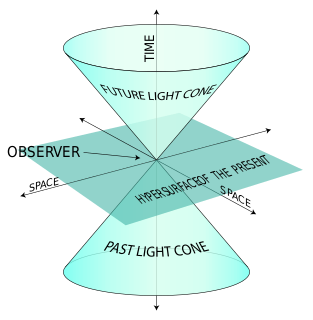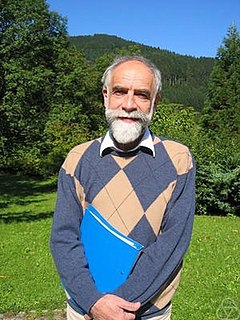In theories of quantum gravity, the graviton is the hypothetical quantum of gravity, an elementary particle that mediates the force of gravitational interaction. There is no complete quantum field theory of gravitons due to an outstanding mathematical problem with renormalization in general relativity. In string theory, believed to be a consistent theory of quantum gravity, the graviton is a massless state of a fundamental string.

Renormalization is a collection of techniques in quantum field theory, the statistical mechanics of fields, and the theory of self-similar geometric structures, that are used to treat infinities arising in calculated quantities by altering values of these quantities to compensate for effects of their self-interactions. But even if no infinities arose in loop diagrams in quantum field theory, it could be shown that it would be necessary to renormalize the mass and fields appearing in the original Lagrangian.

In quantum physics an anomaly or quantum anomaly is the failure of a symmetry of a theory's classical action to be a symmetry of any regularization of the full quantum theory. In classical physics, a classical anomaly is the failure of a symmetry to be restored in the limit in which the symmetry-breaking parameter goes to zero. Perhaps the first known anomaly was the dissipative anomaly in turbulence: time-reversibility remains broken at the limit of vanishing viscosity.

Ernst Carl Gerlach Stueckelberg was a Swiss mathematician and physicist, regarded as one of the most eminent physicists of the 20th century. Despite making key advances in theoretical physics, including the exchange particle model of fundamental forces, causal S-matrix theory, and the renormalization group, his idiosyncratic style and publication in minor journals led to his work not being widely recognized until the mid-1990s.
The Coleman–Mandula theorem is a no-go theorem in theoretical physics. It states that "space-time and internal symmetries cannot be combined in any but a trivial way". Since "realistic" theories contain a mass gap, the only conserved quantities, apart from the generators of the Poincaré group, must be Lorentz scalars.

Rudolf Haag was a German theoretical physicist, who mainly dealt with fundamental questions of quantum field theory. He was one of the founders of the modern formulation of quantum field theory and he identified the formal structure in terms of the principle of locality and local observables. He also made important advances in the foundations of quantum statistical mechanics.
Causal perturbation theory is a mathematically rigorous approach to renormalization theory, which makes it possible to put the theoretical setup of perturbative quantum field theory on a sound mathematical basis. It goes back to a seminal work by Henri Epstein and Vladimir Jurko Glaser.
The Poincaré Seminars, named for the mathematician and theoretical physicist Henri Poincaré, were founded in 2001. They are nicknamed Bourbaphy for their inspiration by the Bourbaki Seminars.
In mathematical physics, Gleason's theorem shows that the rule one uses to calculate probabilities in quantum physics, the Born rule, can be derived from the usual mathematical representation of measurements in quantum physics together with the assumption of non-contextuality. Andrew M. Gleason first proved the theorem in 1957, answering a question posed by George W. Mackey, an accomplishment that was historically significant for the role it played in showing that wide classes of hidden-variable theories are inconsistent with quantum physics. Multiple variations have been proven in the years since. Gleason's theorem is of particular importance for the field of quantum logic and its attempt to find a minimal set of mathematical axioms for quantum theory.

The light-front quantization of quantum field theories provides a useful alternative to ordinary equal-time quantization. In particular, it can lead to a relativistic description of bound systems in terms of quantum-mechanical wave functions. The quantization is based on the choice of light-front coordinates, where plays the role of time and the corresponding spatial coordinate is . Here, is the ordinary time, is one Cartesian coordinate, and is the speed of light. The other two Cartesian coordinates, and , are untouched and often called transverse or perpendicular, denoted by symbols of the type . The choice of the frame of reference where the time and -axis are defined can be left unspecified in an exactly soluble relativistic theory, but in practical calculations some choices may be more suitable than others.
In mathematical physics, de Sitter invariant special relativity is the speculative idea that the fundamental symmetry group of spacetime is the indefinite orthogonal group SO(4,1), that of de Sitter space. In the standard theory of general relativity, de Sitter space is a highly symmetrical special vacuum solution, which requires a cosmological constant or the stress–energy of a constant scalar field to sustain.

Group field theory (GFT) is a quantum field theory in which the base manifold is taken to be a Lie group. It is closely related to background independent quantum gravity approaches such as loop quantum gravity, the spin foam formalism and causal dynamical triangulation. It can be shown that its perturbative expansion can be interpreted as spin foams and simplicial pseudo-manifolds. Thus, its partition function defines a non-perturbative sum over all simplicial topologies and geometries, giving a path integral formulation of quantum spacetime.

Frank Verstraete is a Belgian quantum physicist who is working on the interface between quantum information theory and quantum many-body physics. He pioneered the use of tensor networks and entanglement theory in quantum many body systems. He is full professor at the Faculty of Physics at Ghent University.

Jürg Martin Fröhlich is a Swiss mathematician and theoretical physicist. He is best known for introducing rigorous techniques for the analysis of statistical mechanics models, in particular continuous symmetry breaking, and for pioneering the study of topological phases of matter using low-energy effective field theories.
In quantum field theory in curved spacetime, there is a whole class of quantum states over a background de Sitter space which are invariant under all the isometries: the alpha-vacua. Among them there is a particular one whose associated Green functions verify a condition consisting to behave on the light-cone as in flat space. This state is usually called the Bunch–Davies vacuum or Euclidean vacuum, actually was first obtained by N.A. Chernikov and E. A. Tagirov, in 1968 and later by C. Schomblond and P. Spindel, in 1976, in the framework of a general discussion about invariant Green functions on de Sitter space. The Bunch–Davies vacuum can also be described as being generated by an infinite time trace from the condition that the scale of quantum fluctuations is much smaller than the Hubble scale. The state possesses no quanta at the asymptotic past infinity.

Asymptotic safety is a concept in quantum field theory which aims at finding a consistent and predictive quantum theory of the gravitational field. Its key ingredient is a nontrivial fixed point of the theory's renormalization group flow which controls the behavior of the coupling constants in the ultraviolet (UV) regime and renders physical quantities safe from divergences. Although originally proposed by Steven Weinberg to find a theory of quantum gravity, the idea of a nontrivial fixed point providing a possible UV completion can be applied also to other field theories, in particular to perturbatively nonrenormalizable ones. In this respect, it is similar to quantum triviality.
Joel Shalom Feldman is a Canadian mathematical physicist and mathematician.
John Clements Collins is a British-born American theoretical physicist and professor of physics at Pennsylvania State University. He attended the University of Cambridge where he obtained a B.A. in mathematics 1971 and a Ph.D. in theoretical physics in 1975. He worked as a postdoc and assistant professor from 1975 to 1980 at Princeton University. Collins was part of the faculty of the Illinois Institute of Technology from 1980 to 1990. From 1990 to the present, he has been a faculty member in the department of physics at Pennsylvania State University where he currently holds the position of Distinguished Professor. He is a Fellow of the American Physical Society and received the Guggenheim Fellowship in 1986. In 2009, he was awarded the Sakurai Prize along with R. Keith Ellis and Davison E. Soper.
Antti Kupiainen is a Finnish mathematical physicist.

Krzysztof Gawędzki was a Polish-born French mathematical physicist.








